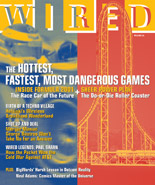The Fine Art of Restoration
Technology adaptations allow conservators to peek under Old Master paint
 Wired Magazine: Even the Old Masters made mistakes – but they lay hidden by perfect paint for centuries. Now conservators are adapting technology to peer inside famous artworks.
Wired Magazine: Even the Old Masters made mistakes – but they lay hidden by perfect paint for centuries. Now conservators are adapting technology to peer inside famous artworks.
Three techniques are used. X-rays document fabric weave, wood grain and paint layers. Ultraviolet radiation examines the varnish. And infrared radiation can reveal the artist’s original sketch (the underdrawing) and later compositional changes.
Dutch physicist Van Asperen de Boer first adapted military night-vision technology in the 1960s. Yet the resulting vidicon camera was clumsy to operate.
A small closed-circuit television monitor portrayed the infrared image. Conservators then took photographs with a 35mm camera, spliced them together and glued together a mosaic.
Yvonne Szafran, associate painting conservator at the Getty Museum, used this popular technique and said it had “inherent vices”, such as unevenness in sensitivity and frayed edges.
Now a handful of world-class museums have turned to platinum silicide cameras, which deliver images straight into a computer. Adobe Photoshop greatly improves the mosaic process as well.
Yvonne Szafran looks at a broad range of Old Master paintings. “Certain time periods work best: 15th and 16th century Flemish, Dutch and Italian artists are particularly successful,” she explained.
“Many 18th century works have a coloured background. It’s a wonderful technique but makes it difficult to see the underdrawing.”
Sometimes artists have noted what colours to use, a sort of “paint by numbers” to guide assistants. Infrared reflectography revealed that one of the Getty’s Renaissance paintings was sliced from a larger work. Hunting on the Lagoon by Carpaccio was briefly reunited with its famous counterpart in Italy, Two Venetian Women.
“One disadvantage of our camera is the image size, 256 x 256 pixels. It’s much too small,” she said. An average-sized painting – 2ft x 3ft – takes her about eight hours to scan.
“We chose this because it is very portable and runs off a battery pack. I can take it travelling and capture images into a laptop.”
The National Gallery of Art chose a bulkier, studio-based Mitsubishi camera. Painting Conservator Elizabeth Walmsley knits together the 512 x 512 images electronically.
“We prefer Photoshop because there’s so many instruction manuals and such a large community of users,” said Walmsley, who currently analysing infrared images at the American Academy in Rome.
“Remote sensing satellite software also can be helpful, as it looks at minerals in the earth’s crust. We examine paint, which is often just pulverised minerals.”
Mitsubishi infrared cameras are used by fire-fighters to identify “hot spots”, detect landmines and in medical treatments, such as heart surgery, passive mammography, burn analysis and soft tissue injury.
Yet this adapted technology isn’t cheap. “Our first camera was donated in 1992 and cost $125,000. In four years, the price halved.”
Szafran is frustrated: “The cameras are very expensive. We keep hoping the price will drop for other museums who don’t have big budgets. If anything, the price has gone up. We’re such a small field, it’s just not a money-maker.”
The National Gallery in London has developed specific software, but it’s based on Unix, not PC or Mac. “A new Windows version is due out,” she continued. “You tell the computer what areas you want to overlap and it blends them together.”
In the meantime, conservators will continue “making do”. The Straus Center for Conservation, located in Harvard’s Fogg Art Museum, provides an excellent on-line example of such ingenuity: http://www.artmuseums.harvard.edu/Renaissance/index.html
Szafran’s research will be displayed in Cologne in April. Infrared reflectography helped her and Getty Paintings Curator Denise Allen attribute a work to the elusive Master of the Saint Bartholemew Altarpiece.
The Getty also will host an exhibit, opening in May, entitled “The Making of a Northern Renaissance Panel Painting”, including reflectographs.